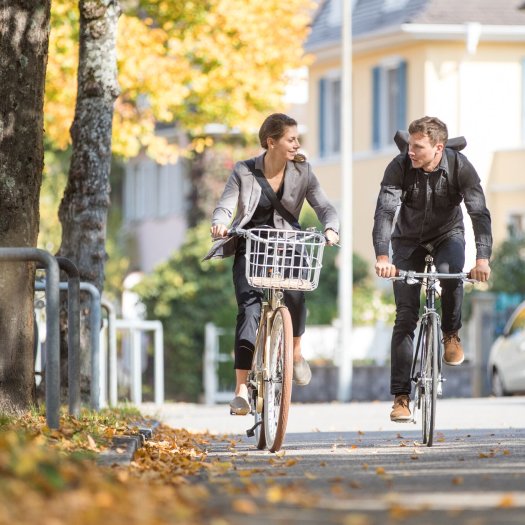- What does Copenhagenize stand for?
- What is typical for Copenhagenize?
- What is the data basis for those responsible?
- What is the Copenhagenize Index?
- Who won the index last time?
- How do German cities perform?
- What are the international implications of Copenhagenizing?
- What is the future of the project?
The idea for Copenhagenize came from Mikael Colville-Andersen. The designer, author and speaker started the Copenhagenize Design Company in 2007, launching a veritable international movement for more bicycle culture. His idea and philosophy is to make urban planning bicycle-friendly with concepts that are as simple as possible. In the meantime, he has presented his concepts in more than 100 cities around the world - combined with the ability to clothe the ideas in new terms. He coined terms like "cycle chic," "citizen cyclist," "bycicle urbanism" - and Copenhagenize. Today, there is a large team behind Copenhagenize - the people responsible, who work in offices in Copenhagen, Paris and Montreal, explicitly do not call themselves "cyclists. They are simply people who like to cycle around - and who know that a larger number of cyclists leads to a higher quality of life in cities.
Away from the car, toward the bicycle - this is how large cities should develop according to the idea. The example of Copenhagen shows that Sunday speeches about bicycle-friendly cities are not enough, but that tangible work is needed. It has built its own bike bridges, expanded bike lanes and, since 2012, has had bike highways. These are not only larger and wider bike lanes, they have also been linked, for example, to a new type of traffic light system that adapts to the average speed of cyclists and thus reduces the number of speed-taking stops. Large bicycle parking garages have also long been part of Copenhagen's cityscape and thus of Copenhagenize.
The data collected by the team around Copenhagenize is impressive. As recently as the early 1970s, there were more than three and a half times as many cars on the road in Copenhagen as bicycles. The number of cyclists did increase steadily over the years. But it wasn't until the project began that the curve increased steeply - and in 2016, for the first time, more bicycles entered downtown Copenhagen than cars. The main reason for Copenhageners to ride their bikes, however, has nothing to do with increased environmental awareness. Fifty-six percent said the motive was that cycling is simply much faster. In fact, a comparison trip through the city from the same starting point to the same destination showed 37 minutes travel time for the car, but only 13 minutes for the bicycle. Cyclists were simply able to get to their destination much more directly. Another analysis is also impressive, namely on space consumption. In the area of Hans Christian Andersen Boulevard, the study authors found that bicycles accounted for 62 percent of commuting traffic - but they had only seven percent of the traffic space available for this purpose. Cars, on the other hand, accounted for only nine percent of commuting traffic, but had 54 percent of the traffic space available.
Since 2011, the Copenhagenize Index has provided an objective comparison of bicycle-friendliness in major cities around the world. Using a total of 14 parameters, the authors of the index award points from 0 to 4 to cities with more than 600,000 inhabitants. Points are awarded, for example, for a particularly well-developed network of bike paths, which is now common in many cities. In addition, there should be as dense a network of bicycle parking spaces as possible and as many traffic-calmed and therefore bicycle- and pedestrian-friendly zones as possible. Cities can also score points if at least the same number of women as men demonstrably use bicycles or if they have many rental bikes on offer. The use of cargo bikes as a means of transport or a high reputation for cycling also earn points. And urban planning according to the motto "bike first" is also rewarded.
The Copenhagenize Index is compiled every two years. In the latest edition in 2019, Copenhagen scored 90.2 percent of the possible points, just ahead of Amsterdam (89.3 percent) and Utrecht (88.4 percent) in the Netherlands. This was Copenhagen's third consecutive win of the award, which has been given out five times so far - Amsterdam was successful twice before that. The cities behind it already had a clear gap in the points achieved - Antwerp, Strasbourg, Bordeaux, Oslo and Paris followed. In the next index, however, Oslo could make a significant leap forward. The Norwegian metropolis won the title of "Rising Star" and is seen as an example of how great progress can be made even in a short time. Oslo is now also seen as an example for all cities that say they are too hilly or snowy for cycling.
In the 2019 index, Bremen was ranked eleventh, the best of the German cities. The city on the Weser came into the ranking as a newcomer - the index makers praised steady progress and ambitious projects in bicycle traffic, with which Bremen had quietly overtaken the other German cities. But there was still praise for Germany - it was developing into Europe's cycling hotspot. Berlin landed in 15th place in the latest ranking, Hamburg in 20th, but the long-term comparison shows that other major cities are doing more. In 2011, Berlin was still in 4th place, Munich in 6th, Hamburg in 11th. Bit by bit, German metropolises have moved down the rankings since then - an indication that other major cities are making more effort.
The initiative, launched in 2007, has developed into a project supported by major cities around the world. Barcelona, Strasbourg and Paris are among the partners, along with a number of other cities. The team, which has since become experts in bicycle-oriented urban planning, works with major cities around the world and makes concrete recommendations to the cities to make them more bicycle-friendly. In addition to the Copenhagenize Index, the team also regularly produces new studies. For example, one study produced this year was devoted to the topic of women and cycling. One of the study's hooks was that many women still report sexual harassment in public transport. Cycling can and should give them more independence from public transport here - yet more men cycle than women. This is due, among other things, to risks of assault that women face - especially in the evening and at night. From studies of this kind, the Copenhagenize team makes recommendations for major cities - in this case, for example, an even better protected bicycle infrastructure.
In September, there will be a so-called Master Class in Montreal, Canada, the American home of Copenhagenize. Over the course of three days, there will be an exchange of experiences with the cycling infrastructure - also against the background of different mentalities and cycling cultures between the continents.
- ISPO awards
- Mountain sports
- Bike
- Design
- Retail
- Fitness
- Health
- ISPO Job Market
- ISPO Munich
- ISPO Shanghai
- Running
- Brands
- Sustainability
- Olympia
- OutDoor
- Promotion
- Sports Business
- ISPO Textrends
- Triathlon
- Water sports
- Winter sports
- eSports
- SportsTech
- OutDoor by ISPO
- Heroes
- Transformation
- Sport Fashion
- Urban Culture
- Challenges of a CEO
- Trade fairs
- Sports
- Find the Balance
- Product reviews
- Newsletter Exclusive Area
- Magazine







